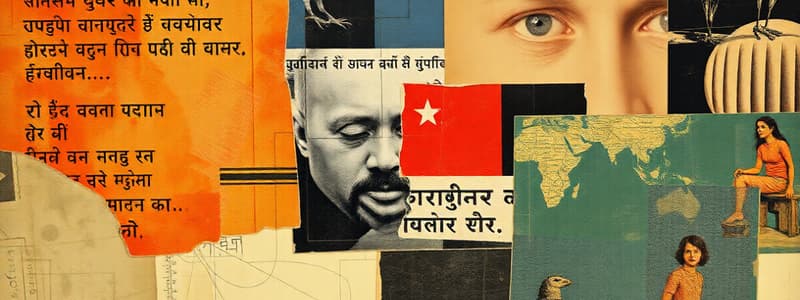Podcast
Questions and Answers
What is the main script used for writing Hindi?
What is the main script used for writing Hindi?
- Devanagari script (correct)
- Arabic script
- Cyrillic script
- Roman script
Which of the following is NOT a major dialect of Hindi?
Which of the following is NOT a major dialect of Hindi?
- Khari Boli
- Bhojpuri
- Sanskrit (correct)
- Maithili
What is the typical sentence structure of Hindi?
What is the typical sentence structure of Hindi?
- Subject-Object-Verb (SOV) (correct)
- Verb-Subject-Object (VSO)
- Subject-Verb-Object (SVO)
- Object-Subject-Verb (OSV)
Which of these languages has influenced Hindi vocabulary the least?
Which of these languages has influenced Hindi vocabulary the least?
What role does Hindi play in Indian media and culture?
What role does Hindi play in Indian media and culture?
Flashcards are hidden until you start studying
Study Notes
Overview of Hindi
- Hindi is an Indo-Aryan language spoken primarily in India.
- It is one of the 22 scheduled languages of India and the official language of the Indian government.
- Hindi is written in the Devanagari script.
Linguistic Classification
- Part of the Indo-European language family.
- Belongs to the Hindi-Urdu group of the Indo-Aryan languages.
- Closely related to Urdu, sharing vocabulary and grammar with some differences in script and literary styles.
Dialects
- Major dialects include:
- Khari Boli (standard Hindi)
- Awadhi
- Bhojpuri
- Magahi
- Maithili
- Each dialect retains unique phonetic and lexical features.
Vocabulary
- Hindi has borrowed vocabulary from:
- Sanskrit (primary source)
- Persian
- Arabic
- English (especially in modern contexts)
Grammar
- Subject-Object-Verb (SOV) structure.
- Gendered nouns (masculine and feminine).
- Use of postpositions instead of prepositions.
- Tenses expressed through verbs: past, present, and future.
Pronunciation
- Hindi contains 11 vowels and 33 consonants.
- Retroflex sounds are distinctive, common in South Asian languages.
Cultural Significance
- Hindi is a medium of instruction in many educational institutions in India.
- Significant in literature, cinema (Bollywood), and music.
- Used widely in media and news broadcasting.
Global Presence
- Hindi is the fourth most spoken language in the world.
- Increasingly recognized in diaspora communities across the globe, particularly in the USA, UK, Canada, and Australia.
Language Learning
- Hindi language courses offered globally in universities and language institutions.
- Resources include textbooks, online courses, and immersive methods.
Modern Developments
- Influence of technology and social media on vocabulary and usage.
- Efforts to promote standard Hindi while fostering regional dialects and languages.
Overview
- Hindi is spoken primarily in India and is one of the 22 scheduled languages of India.
- Hindi is the official language of the Indian government.
- Hindi is written in the Devanagari script.
Linguistic Classification
- Part of the Indo-European language family and belongs to the Hindi-Urdu group.
- Closely related to Urdu, sharing vocabulary and grammar with some differences in script and literary styles.
Dialects
- Major dialects include Khari Boli (standard Hindi), Awadhi, Bhojpuri, Magahi and Maithili.
- Each dialect retains unique phonetic and lexical features.
Vocabulary
- Hindi has borrowed vocabulary from Sanskrit, Persian, Arabic and English.
- Sanskrit is the primary source of vocabulary.
- English vocabulary is increasingly common in modern contexts.
Grammar
- Subject-Object-Verb (SOV) structure which is uncommon for many European Languages.
- Gendered nouns are utilized.
- Postpositions are used instead of prepositions, similar to the use of prepositions in most European languages.
Pronunciation
- Hindi contains 11 vowels and 33 consonants.
- Retroflex sounds are distinctive and common in South Asian Languages.
Cultural Significance
- Hindi is a medium of instruction in many educational institutions in India.
- Hindi is significant in literature, cinema (Bollywood), and music.
- Used widely in media and news broadcasting.
Global Presence
- Hindi is the fourth most spoken language in the world.
- Increasingly recognized in diaspora communities across the globe, particularly in the USA, UK, Canada, and Australia.
Language Learning
- Hindi language courses offered globally in universities and language institutions.
- Resources include textbooks, online courses, and immersive methods.
Modern Developments
- Influence of technology and social media on vocabulary and usage.
- Efforts to promote standard Hindi while fostering regional dialects and languages.
Studying That Suits You
Use AI to generate personalized quizzes and flashcards to suit your learning preferences.




